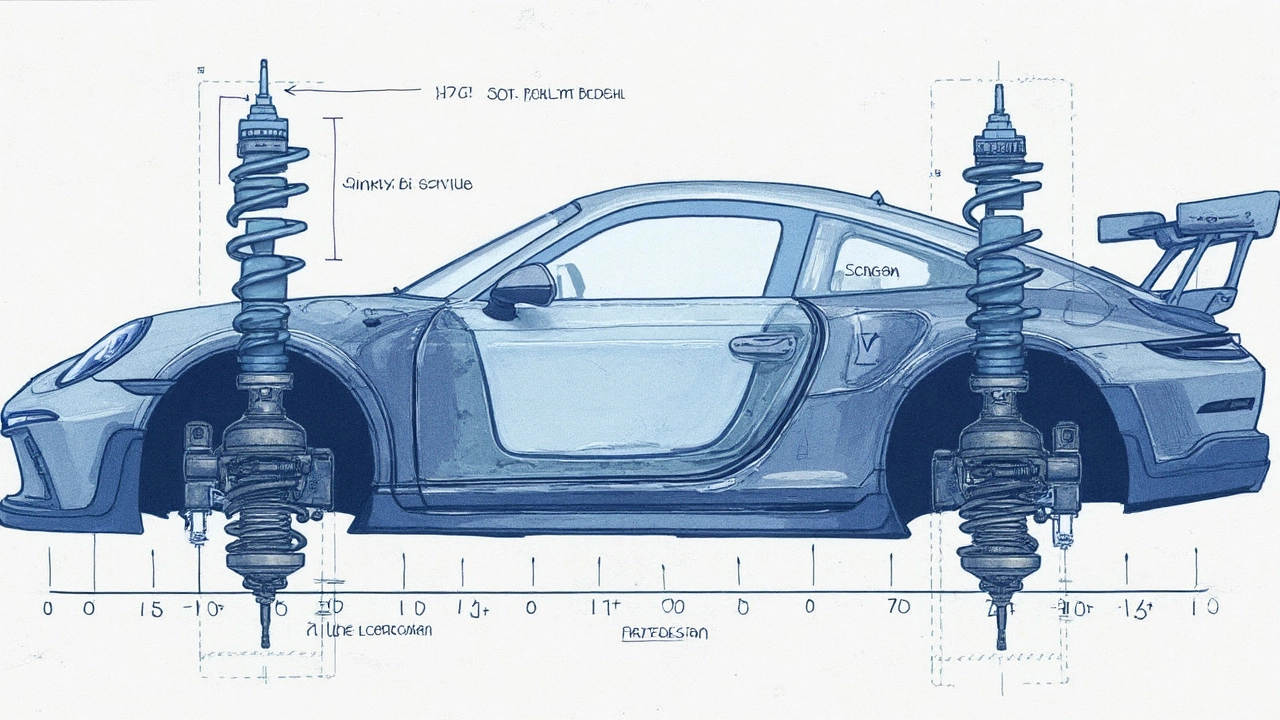Ever thought about giving your car that low, mean look with some lowering springs? These neat little upgrades not only transform the stance of your ride but also tweak how it handles. But hey, is it enough just to swap in those springs, or does the whole suspension system need a makeover, particularly those shocks?
Alright, let's tackle this. Lowering springs can reduce your car's center of gravity, enhancing the way it grips the road, especially around tight corners. But what about those shocks? Technically, they work with your springs to absorb bumps and keep the tires connected to the pavement. If you're changing one, the balance with the other might get a little whacked, affecting performance.
So, should you replace shocks too? Well, it's not a hard and fast rule, but there are solid reasons to consider it. For one, matching lowering springs with compatible shocks can preserve ride comfort and prevent weird wear and tear. Plus, you might get better handling and response from your car—all while avoiding that annoying bouncy castle effect!
- Understanding Your Car's Suspension System
- What Lowering Springs Do
- Why Consider Replacing Shocks
- Impact on Ride Quality and Handling
- Tips for Maintaining Your Modified Suspension
Understanding Your Car's Suspension System
Alright, let's get into the nitty-gritty of what actually keeps your ride smooth on the road: your car’s suspension system. It's not just a bunch of random parts thrown together—it's a carefully designed mix of springs, shocks, struts, and control arms, all working in harmony. The main job? Keeping your wheels glued to the road while giving you a comfy ride.
The shocks and struts are like your car's shock absorbers, taming all those bumps and dips. Think of them as the unsung heroes of your daily commute, helping to control the motion of the springs and improve handling and stability.
Your springs, on the other hand, bear the weight of the vehicle and its cargo, providing much of the suspension’s flexibility. Together, these components ensure that your car can corner well, brake safely, and avoid skidding, regardless of the road conditions.
"The suspension system not only gives the driver control but also isolates the vehicle from road shocks and vibrations," says Adam Simmons, a vehicle dynamics engineer at AutoTech Innovations.
Fun fact: The effectiveness of a suspension system isn't just about a smooth ride. It's directly tied to the car's ability to maintain grip and traction. You want your tires to stay in contact with the road, especially when one of those unexpected potholes shows up!
| Suspension Component | Function |
|---|---|
| Springs | Support vehicle weight and absorb energy from road irregularities. |
| Shocks/Struts | Control the movement of springs and reduce bounce. |
| Control Arms | Connect wheels to the frame, allowing for controlled movement. |
So, when you’re planning to add those lowering springs and wondering if the shocks need upgrading too, think of how all these components work together. Keeping your suspension system balanced is crucial for safe and enjoyable driving.
What Lowering Springs Do
So, what's the magic behind lowering springs? Well, these guys are designed to drop your car closer to the ground, which can dramatically change its look and feel. Imagine slicing through wind resistance like a sleek dart on wheels! But lowering your ride isn’t just about aesthetics.
When you install lowering springs, you're effectively lowering the car's center of gravity. This shift can enhance stability during cornering, making tight turns feel smoother and more controlled. Basically, your car hugs the road more closely, reducing body roll, which is that tilty feeling when your car leans on curves. This can lead to improved handling, making every drive feel a bit more like a professional rally race.
Here's a cool fact: lower cars usually have less air drag, which may increase fuel efficiency by a smidge. Not a bad side effect for looking cool, right?
But there's more! By using lowering springs, you're altering the suspension geometry and reducing the distance between the fender and tires. This gives a firmer ride, which can enhance the feedback you get from the road. Think of it as a more connected driving experience.
On the flip side, because your car's sitting lower, there's also less space for compressing your suspension over bumps. This can lead to a stiffer ride, so if you're driving on roads that resemble the moon’s cratered surface, you might feel more of those bumps.
So there you go—a taste of what lowering springs bring to the table. They offer more than just a flashy drop. They change the dynamics of your car’s performance and ride quality, all while contributing to that eye-catching, low-profile look.

Why Consider Replacing Shocks
So, you're thinking about lowering springs and wondering if replacing shocks at the same time is really worth it. Let's clear up why this might be a smart move.
First off, let's talk collaboration. The relationship between shocks and lowering springs is like a well-practiced dance duet. Lowering springs change the height and dynamics of your car, and the shocks need to keep up with the new rhythm. If your old shocks aren't designed to handle these changes, you could end up with poor ride quality and even jeopardize safety.
Imagine hitting a speed bump. With mismatched shocks, you'd feel every jolt and bounce, and not in a fun way. Compatible shocks help absorb these impacts smoothly, distributing energy more evenly to prevent that bouncy, uncontrolled feel.
- Smoother Ride: Matched shock absorbers can significantly improve ride comfort by adjusting to the new spring tension better.
- Extended Suspension Life: By using compatible shocks, you reduce unnecessary strain, which might otherwise wear components out faster.
- Improved Handling: Car enthusiasts know that handling is all about balance. The right shocks can ensure your car corners like a pro, reducing body roll and improving grip.
Financially, replacing shocks with the springs can save you money in the long run. How, you ask? If the old shocks fail prematurely because they weren't designed to handle the lower setup, you're looking at another round of suspension tweaks. Better to do it all in one go!
In a nutshell, if you're investing in some snazzy lowering springs to boost your vehicle's aesthetics and performance, don’t skimp on the shocks. It's a combo that works best together for a smoother, safer drive.
Impact on Ride Quality and Handling
Switching out your springs for lowering springs is like giving your car a makeup makeover, but what does it do to the feel of your ride? Dive into the nitty-gritty of ride quality and handling, and you'll find that the relationship between springs and shocks is a bit like a dance duo that must stay in sync.
When you install lowering springs, the vehicle's center of gravity drops, which is excellent for reducing body roll in corners. This can make your car feel more planted, especially when whipping through twisty roads. However, without the right shocks to match, you could end up with a vehicle that's stiff but unrefined, bouncing over every pebble or pothole.
"The harmony between springs and shocks is crucial because it influences every aspect of driving dynamics," notes James Smith, a veteran suspension engineer at Auto Dynamics.
If you're thinking of tackling both, investing in performance or adjustable shocks might be the way. They can help you fine-tune how your car handles different terrains and conditions. Compatibility is key here— mismatched shocks and springs can lead to uneven tire wear, which nobody wants.
Curious how this all shakes out practically? Well, consider this: With the right setup, your modified suspension can actually enhance braking. A study showed that cars with optimized suspension systems reduced stopping distances by up to 5%, thanks to the improved tire contact with the road.
| Aspect | Effect with Lowering Springs |
|---|---|
| Body Roll | Reduced |
| Handling | Improved with proper shocks |
| Ride Comfort | Potentially decreased without compatible shocks |
In the end, balancing aesthetics with performance is doable. By understanding the relationship between shocks and lowering springs and perhaps splurging a bit on compatible gear, you'll get a ride that not only looks the part but feels fantastic too.

Tips for Maintaining Your Modified Suspension
So, you've got those lowering springs and maybe even new shocks. Sweet! But how do you keep everything running smooth and avoid costly fixes? Good maintenance is the key. Let's break it down into a few easy steps.
First up, regularly check your suspension components. Look out for any wear or damage. It sounds basic, but catching cracks in springs or leaks in shocks early can save you a headache later. Be thorough with those inspections, especially if you often drive on bumpy roads.
Another tip? Keep the alignment in check. Changing your suspension setup can mess with your vehicle's alignment, affecting handling and accelerating tire wear. Heading to an alignment shop every once in a while ensures your car stays on track—literally.
Don’t forget about those tires. With a modified suspension, how your tires sit on the road can change. Regularly inspect tire tread and pressure, ensuring they’re wearing evenly. Properly inflated, balanced tires not only last longer but also help maintain optimum handling, which is what you're after with those springs and shocks.
Your modified ride might have less ground clearance, so watch out for potholes and speed bumps. Hitting these at speed won't do any favors and could damage your shiny new setup. Drive smart to preserve your car's newfound agility.
Finally, consider a routine maintenance schedule. Just like you'd see the dentist or get a haircut regularly, taking your car to a mechanic familiar with car suspension can help nip issues in the bud. They'll know what to look for in a modified system and keep your ride in top shape.
Maintaining your upgraded suspension isn't just about avoiding problems; it's also about enjoying the best performance. With a little attention and care, you’ll keep that new-found driving thrill alive.




